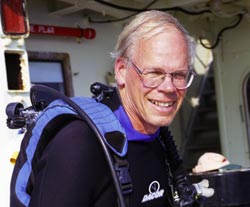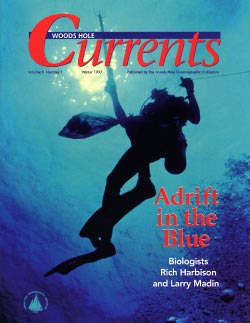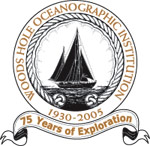This is an archived site. This site is no longer being maintained or reviewed for broken links.
Employee Portrait Gallery—Larry Madin
 |
|
|
Larry Madin is suited up for a dive aboard Oceanus. (Photo by Terry Rioux) |
|
 |
|
Download pdf of 1997 Currents article on Madin & Harbison |
“When the photographer and I surfaced, neither the ship nor the boat was in sight, only the wide blue horizon in every direction.” Larry Madin is describing a 1976 scuba diving expedition 30 miles off North Carolina for the National Film Board of Canada. Larry and a filmmaker had left a chartered ship called Advance (“The old tub should have been called Retreat,” Larry comments) to dive from a rubber boat that was then supposed to follow their bubbles and be available when they were ready to surface. When the boat driver lost track of the bubbles, he decided to return to Advance, leaving the divers to fend for themselves. “Fortunately, the water was warm, and the ship found us about 45 minutes after we surfaced,” Larry says, “but it was a pretty scary experience. That was my first and last untethered open-ocean dive.”
Along with another WHOI biologist, Rich Harbison, Larry pioneered open-ocean scuba diving at WHOI during the mid 1970s in order to collect “jellies” that are too fragile to be netted from ships. It’s easy for divers to lose track of their locations in the open ocean, so Rich and Larry used a tether system early on to be sure they could bring all their divers home.* Larry’s interest in jellies began in 1966 with a salp he saw pickled in a jar as an undergraduate at the University of California (UC), Berkeley. “I was amazed to find out that little was known about how they lived in the ocean.” He’s still expanding the body of knowledge about jellies. Larry did his graduate work with Bill Hamner at UC, Davis, at a time when Hamner’s group was developing near-shore ocean diving techniques to collect their marine specimens. The group undertook an 18-month research adventure to Bimini, where Larry met WHOI biologist Frank Carey. This led to a WHOI postdoc with Rich Harbison.
Their first open-ocean diving cruise was aboard R/V Knorr in 1973, and Captain Hiller was not enthusiastic about sending a boatload of divers away from the ship. (The objective is get away from the noise and disturbance of the large vessel.) “Two large nets and a couple of other things had already been lost on that trip,” Larry says, “and Hiller didn’t want any members of the scientific party to join that list. Eventually we got away in a Zodiac, and captured our first open-ocean specimens.” Their early work showed that jellies form a large component of the plankton and are important factors in the oceanic system. Later, they extended their reach deeper by using submersibles to observe and collect their fragile specimens, and they have contributed substantially to knowledge of blue-water plankton and ecosystems.
Larry served as chair of the Biology Department from 1996 to 2000, when he was named director of the Ocean Life Institute. His interests currently include both polar and tropical oceans. He has made one expedition to study salps in Antarctic waters and is planning another, and he is also organizing WHOI participation in a new tropical laboratory in Panama.
[back]

